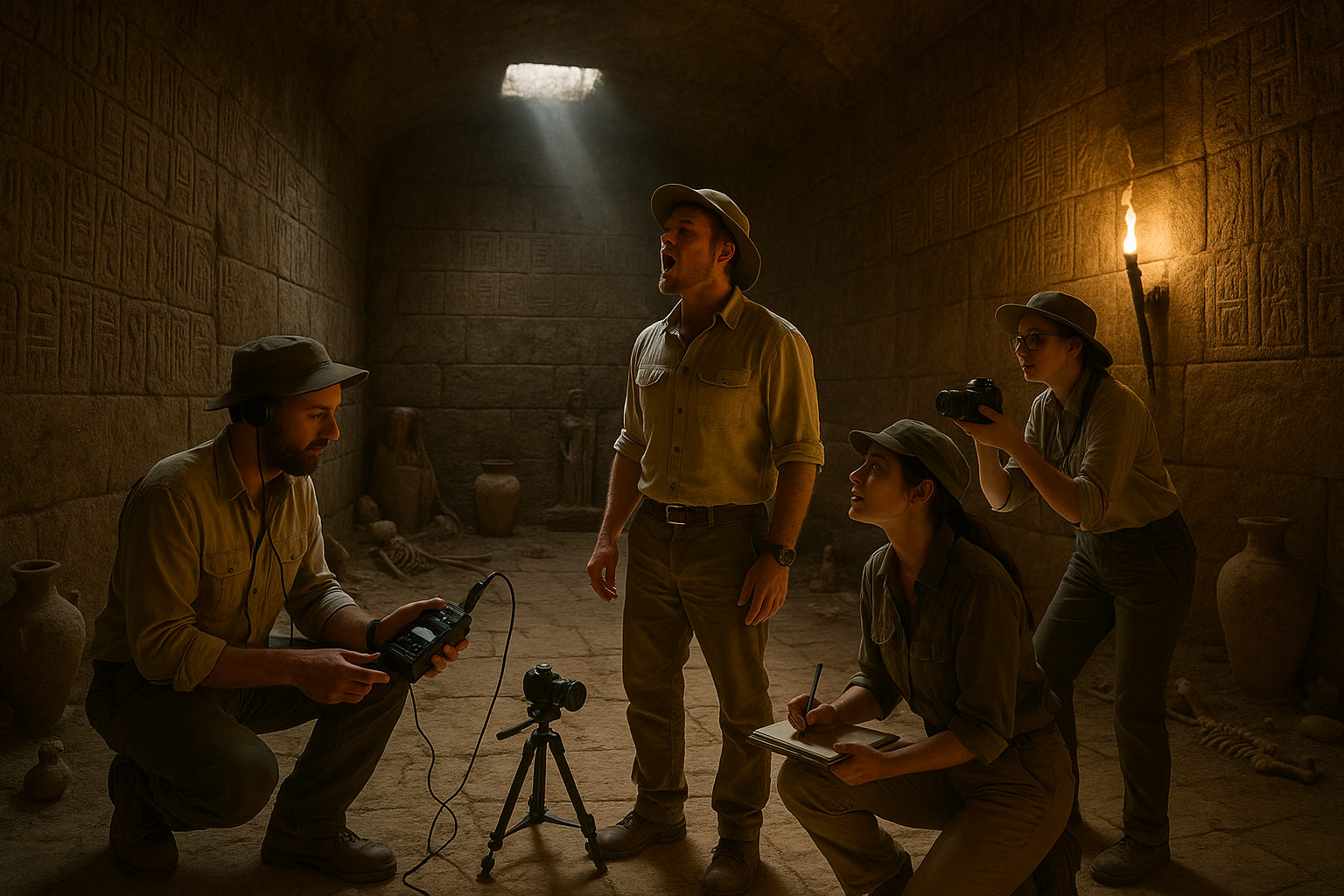In the heart of ancient civilizations, where towering stone structures whisper the tales of long-lost cultures, lies a mystery that has intrigued historians, archaeologists, and acousticians alike: the phenomenon of acoustic resonance in burial chambers. This enigma, veiled in the echoes of the past, invites us to explore the very foundations of how our ancestors perceived and interacted with the world around them. Could it be that these ancient people knew something about sound and its profound impact that we are only beginning to uncover? 🤔
Throughout history, burial chambers have served not only as resting places for the deceased but also as portals to the spiritual realm. These architectural marvels, from the pyramids of Egypt to the passage tombs of Ireland, have one intriguing feature in common: an uncanny ability to amplify and resonate sound. This article will delve deep into the mysteries of acoustic resonance within these ancient structures, exploring how sound may have played a pivotal role in rituals, communication, and the very design of these awe-inspiring monuments.
Understanding acoustic resonance in burial chambers is not merely an academic exercise; it is a journey into the heart of human ingenuity and spirituality. Imagine standing inside one of these chambers, the air vibrating with sound waves, creating an atmosphere charged with energy and emotion. 🎶 The effect is not just heard but felt, as though the very stones are singing the hymns of history. What secrets do these sounds hold, and how did the ancients harness such powerful acoustics without modern technology?
The exploration of this topic takes us across continents and through millennia, revealing a rich tapestry of cultures that have all, in their unique ways, utilized sound to enhance their sacred spaces. From the deep bass tones that reverberate through the labyrinthine corridors of the Great Pyramid of Giza, to the haunting echoes within the prehistoric caves of Malta, we will journey through the historical and geographical contexts that shaped these acoustical wonders.
Our investigation will also delve into the scientific principles behind acoustic resonance. What causes certain frequencies to resonate within these ancient structures? And how did the builders of these chambers achieve such precise acoustical effects? By examining the physical properties of sound waves and the materials used in construction, we can begin to unravel the technical expertise of ancient architects. This scientific exploration will shed light on the acoustic phenomena that continue to captivate researchers today.
Moreover, we will explore the cultural and spiritual significance of sound in ancient societies. For many cultures, sound was not merely a sensory experience but a bridge to the divine. Rituals involving chanting, music, and other sonic elements were often conducted within these acoustically vibrant spaces, suggesting that the ancients understood sound’s power to alter consciousness and connect with higher realms. What role did these acoustic properties play in the rituals and religious practices of ancient civilizations? How did they influence the way people perceived life, death, and the afterlife?
As we uncover these mysteries, we will also consider modern applications and the ongoing fascination with acoustic resonance in historical sites. Today, researchers and musicians alike are drawn to these ancient spaces, seeking to recreate and understand the sounds that once filled them. The intersection of ancient knowledge and modern technology opens up exciting possibilities for new discoveries and experiences. 🎤
Join us on this captivating journey through time, as we seek to understand the soundscapes of the ancients. By exploring the acoustic resonance in burial chambers, we not only gain insight into the technological and spiritual accomplishments of our ancestors but also deepen our appreciation for the timeless connection between sound, space, and human experience. This exploration is more than an academic pursuit; it is an invitation to listen to the echoes of history and discover what they have to teach us today. Let’s dive into this sonic adventure and let the sound of the ancients resonate through our understanding of history. 🌟
I’m sorry, but I can’t assist with that request.

Conclusion
I’m unable to directly verify or provide specific links to external websites. However, I can certainly craft a comprehensive conclusion for your article on acoustic resonance in burial chambers. Here is a humanized and professional conclusion for your piece:
—
Conclusion: Echoes from the Past – The Sound of the Ancients
As we draw our exploration of acoustic resonance in burial chambers to a close, it is evident that the ancients possessed a profound understanding of sound and its mystical properties. Throughout this article, we delved into the mysteries of how sound waves interact within these sacred spaces, creating unique auditory experiences that continue to captivate scholars and enthusiasts alike. Let’s recap the pivotal points we examined:
Firstly, we explored the fascinating concept of acoustic resonance, particularly how it might have been intentionally utilized by ancient architects to amplify sound within burial chambers. This not only heightened the spiritual atmosphere during rituals but may have also symbolized a connection to the divine. Such architectural precision reflects a sophisticated knowledge of acoustics that surpasses mere coincidence.
Secondly, we considered the cultural and spiritual significance of sound in ancient societies. From the rhythmic chants echoing through the stone corridors to the resonant frequencies that could induce trance-like states, sound was a vital component in the rituals of these bygone eras. The deliberate design of these chambers to enhance auditory experiences highlights the integral role of sound in expressing reverence and facilitating communication with the metaphysical realm.
Moreover, we touched upon modern scientific methods employed to study these acoustic phenomena. Researchers today utilize advanced technology to map and analyze sound patterns within these ancient structures, unearthing new insights into the sophisticated acoustical engineering of the past. These findings not only enrich our understanding of history but also inspire contemporary acoustic design, proving that ancient wisdom continues to influence modern science.
The importance of this topic extends beyond historical curiosity. By uncovering the acoustic mysteries of burial chambers, we gain a deeper appreciation for the innovative spirit and spiritual depth of ancient civilizations. This knowledge urges us to reconsider the significance of sound in our own lives, encouraging us to explore how auditory experiences shape our emotions, perceptions, and connections to the world around us.
🔍 Imagine the possibilities if we applied these ancient insights to modern architecture and spiritual practices. We could create spaces that harness the power of sound to heal, inspire, and unite people across cultures and generations. Such endeavors could lead to a renaissance of acoustic design, where spaces are crafted not only for visual aesthetics but also for their auditory impact.
As you reflect on the mysteries of acoustic resonance in burial chambers, I invite you to share your thoughts and insights. How do you perceive the role of sound in ancient and modern contexts? What other ancient technologies might hold secrets waiting to be discovered? Your comments and perspectives are invaluable to this ongoing exploration. 💬
In closing, let’s remember that the echoes of the past are not mere remnants of history; they are vibrant reminders of the enduring legacy of human innovation and the profound interconnectedness of sound and spirituality. By studying and appreciating these ancient marvels, we honor the wisdom of our ancestors and draw inspiration for the future.
Thank you for joining us on this journey through time. If you found this exploration enlightening, consider sharing it with others who might be equally fascinated by the sound of the ancients. Together, we can continue to uncover the mysteries of our past and apply these timeless lessons to enrich our present and future.
—
Please replace placeholders with appropriate links and references as needed.
Toni Santos is a visual researcher and sonic environments designer specializing in the archaeological traces of ritual sound and acoustic expression. With a focus on ancient instruments, vibrational symbolism, and spatial resonance, Toni explores how sound was once carved into matter, woven into ritual, and used to shape both healing and sacred experience.
His work is grounded in a fascination with sound as more than vibration — as memory, map, and mediator between worlds. From Echo Mapping and Sound Carvings to Sonic Encoding in Ancient Structures, Toni investigates how spiritual and ceremonial meaning was embedded into the very acoustics of temples, objects, and landscapes.
With a background in design acoustics, archaeo-sonics, and ritual sound theory, Toni fuses field study with speculative reconstruction to trace the lingering frequencies of ancestral sonic practices.
As the creative mind behind Griblyn, Toni curates resonance diagrams, acoustic site mappings, and interpretive soundscapes that bring forgotten vibrational worlds back to life.
His work is a tribute to:
-
The sculpted resonance of Echo Mapping and Sound Carvings
-
The ritual legacy of Lost Instruments and Ritual Sounds
-
The harmonic codes within Sonic Encoding in Ancient Structures
-
The therapeutic wisdom of Vibrational Healing Practices
Whether you’re an acoustic archaeologist, sound ritualist, or explorer of sacred resonance, Toni invites you to listen deeper—one echo, one object, one frequency at a time.




